 |
|
|
|
Chris Ingram, editor of Unionsafety answers the question in this article written in a personal capacity: With the tragic news from Brazil over this weekend were over 230 people have been killed, most from smoke inhalation, when a night club with only one exit went up in flames with over 1000 people in it; the question is not being asked – could it happen here?
But what is the true risk to the public going clubbers? A lot greater than you think!! The fact is that this Government have been cutting ALL public services since 2010, and this includes major reductions in staffing levels in hospital A&E departments, closures of A&E departments, closures of hospitals, clinics and even GP surgeries. But we must also not forget the cuts being made to the Police, Fire Service, Ambulance Service, Coastguards Stations, Environmental Health Officers, HSE inspectors, and public health services. Whilst not all of these services would be involved in the immediate aftermath of a major incident such as a burning nightclub full of drunken revelers, the fact is that recent major incidents have shown that emergency services have all been stretched. With the cuts in environmental health officers and the downgrading of many public buildings, pubs and nightclubs, to low risk areas, those enforcing agencies responsible for these areas have been subjected to cuts and orders not to pro-actively deal with these areas. Further inspections by EHO are now only being allowed by some local authorities in areas of high risk, and investigations of incidents causing injuries not being allowed unless it has involved deaths or amputations. Further due to the reduction in staffing levels and changes to enforcement practices being brought in to date, the chances of fire certificates being out of date or not existing at all, dangerous practices such as fire exists being locked or blocked making them inaccessible, or simply not existing at all; poses the greatest risk to public safety we have seen since the great Woolworth’s fire in 1979.
In an event such as that which took place over the weekend in Brazil, all these services would need to be utilised. The Fire Brigades Union, last year issued a document in which they provided the evidence and argument that the cuts and even further cuts to come, will cause injuries and even deaths. Just two facts from the document alone make worrying reading: * Over the last 2 years, since the coalition government came into power, around 1,500 frontline fire-fighter jobs have been lost. * Response times are almost two minutes slower on average than a decade ago – and this masks even slower responses in some areas and to some incidents. Many fire and rescue services are missing their own targets for the arrival of the first and second appliance. The privatisation of the supply and maintenance of equipment to the Fire Brigade in areas such as London has been directly responsible for delays in equipment renewals, equipment failures and ultimately that fact in itself poses an ongoing risk to public safety. But the Ambulance Service does not get off the hook, and things will only get worse. The Government has embarked on the privatisation of the NHS, and from April 2013 the responsibility for the commissioning of ambulance services transfer from primary care trusts to GP consortia. Currently, in England 11 NHA Ambulance Trusts provide all ambulance services. Ever since 2010, all over England ambulance services are being cut and privatised, as a result of budget cuts imposed upon local National Health Trusts. This despite the fact that the Government’s own National Audit Office says in its 10th June 2011 report into the Ambulance Service; “The ambulance service has a pivotal role to play in the performance of the entire urgent and emergency care system” Further, the Ambulance Service is subject to a 4% cut in its budget, imposed as part of the Governments cut of £20 Billion pounds to the budget of the NHS.
In East of England Ambulance Service, front line ambulances have been withdrawn from many parts of the region, resulting in Police increasingly having to take patients to hospital in emergencies 'due to ambulance cuts' according to Steve William, Chairman of the Police Federation of England and Wales. The closing down of ambulance stations and transferring of staff and vehicles to large ‘hub stations’ is widespread across England.
But as always with this government money is put before patients lives. NWAS is currently closing down ambulance stations, opening up large hubs and introducing ‘deployment points’ being co-located with other emergency services such as Fire and Rescue, Police or NHS. This practice of having ‘deployment points’ scattered around towns and cities is a system similar to that used by Canada and The USA’s ambulance services which are all privately run, many by small businesses. Ambulances can be seen in lay-bys, in side streets, and near motorways from time to time awaiting calls from central despatch to attend an emergency. There is no evidence that this system is any better at providing emergency services, but does provide for concern over distances covered and response times. In Manchester Ambulance Services to non-urgent patients are being privatised with Arriva Bus Company having won the contract to provide ambulance services. Until 1 April 2011, ambulance responses were split into three categories: A – immediately life-threatening; In 2011 Health Secretary Andrew Lansley abolished the target for so-called ‘category B’ emergencies – those classed as serious but not life-threatening. Since then ambulances no longer have to arrive at emergencies such as road accidents, train crashes and even explosions, within 19 minutes. Given that fact and for all of the reasons given in this article, the answer to the question ‘Could an incident such as the Brazil nightclub fire happen here’; must be a very loud Yes! You can download the FBU document on Fire and Rescue Services cuts here Also the National Audit Office report entitled Transforming NHS Ambulance Services can be downloaded here Source: FBU / NOA / MEN / BBC News / Unison / St Helens Council / NWAS NHS Trust/ Daily Telegraph website See also: Fire Services In Devon And Somerset To Lose 140 Front-line Posts
|

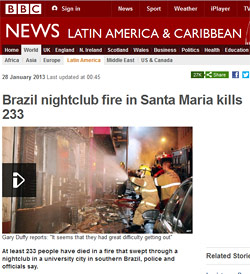
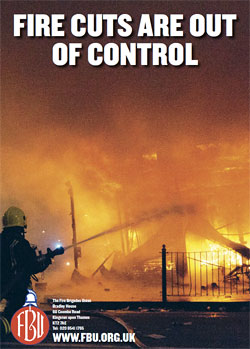 The Fire and Ambulance services across the country have seen major losses in staffing levels, as well to the police services.
The Fire and Ambulance services across the country have seen major losses in staffing levels, as well to the police services.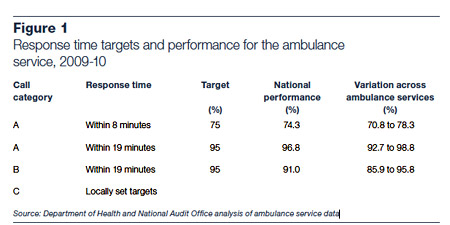 Delays to arrivals have resulted in patient’s lives being put at risk across the country, as reported in local and national media in the last 6 months.
Delays to arrivals have resulted in patient’s lives being put at risk across the country, as reported in local and national media in the last 6 months. 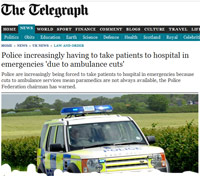
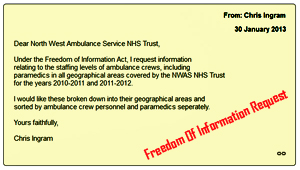 North West Ambulance Service currently operates from 109 ambulance stations, which cost £1.8 million a year to maintain. They run 341 ambulances and 134 paramedic vehicles.
North West Ambulance Service currently operates from 109 ambulance stations, which cost £1.8 million a year to maintain. They run 341 ambulances and 134 paramedic vehicles.